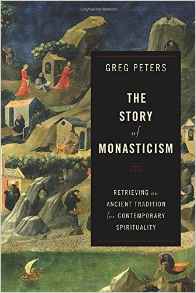 Greg Peters, The Story of Monasticism: Retrieving an Ancient Tradition for Contemporary Spirituality (Grand Rapids: Baker Academic, 2015), 278pp.
Greg Peters, The Story of Monasticism: Retrieving an Ancient Tradition for Contemporary Spirituality (Grand Rapids: Baker Academic, 2015), 278pp.
A review by W. David Buschart, co-author most recently of Theology as Retrieval: Receiving the Past, Renewing the Church (InterVarsity Press Academic, 2015).
Beginning in the late-1970s, many evangelical Christians began to adopt the language of “spirituality” to talk about the Christian life. This wasn't simply a change of terminology. It was reflective of many evangelical Christians beginning to look more broadly for wisdom and guidance for life with God.
They looked “more broadly” both chronologically — looking back in history, and ecclesiastically — considering Christian traditions and denominations that they hadn't considered before. The Story of Monasticism is a recent example of this “broader” approach to Christian spirituality by evangelicals. The author, Greg Peters, is associate professor of medieval and spiritual theology in the honors program of Biola University, and a Benedictine oblate. He's a most able and helpful guide.
The introductory chapter provides a definition and orienting description of “monasticism.” Monastics are “those who intentionally live alone or in community under a rule of life and vows that give shape to their daily routine and shared mission in life.” This is accompanied by an account of “religious calling” in the Bible, from Adam and Abraham to Paul and Mary and Martha. Peters observes that “a contemplative aspect is a common feature of religious callings in the Christian Scriptures,” and that “the Bible teaches the good practices of living with others communally, taking vows to God, and praying at fixed times.” Thus, these practices of monasticism “have biblical precedent.”
In the body of the book Peters takes readers on a chronologically comprehensive walk through the history of monasticism, from Antony of Egypt to Benedict of Nursia (4th – 6th c.), from Benedict to Bernard of Clairvaux (6th – 12th c.), from Bernard to Martin Luther (12th – 16th c.), and from Luther to Thomas Merton (16th – 20th c.), with three or four chapters devoted to each of these eras.
Each of the fifteen chapters ends with a brief exercise in “ressourcement.” This kind of looking-back to yesterday for wisdom today is much of what ressourcement is about, and Peters is a recognized proponent and practitioner. Thus, these sections at the end of each chapter offer his “take-away” and challenge to readers, the challenge — or invitation — to listen to and learn from the voices and lives of monastics.
Peters is not trying to coerce people to leave their jobs in computer programming or real estate and move to the desert. He himself is a married father and university professor. He does, however, think that computer programmers and real estate agents — indeed any follower of Christ — would do well to watch, listen and learn from the contemplative and active principles and practices of monasticism.
For example, in the ressourcement for the chapter on Benedictine monasticism, Peters points to monastic principles and practices that help to cultivate humility, obedience and hospitality. He then suggests how these principles and practices might inform the shape of church life. After all, “The monastery was never meant to supplant the church,” and the fact is that "monastic" virtues — such as humility, obedience and hospitality, “are open to all Christians, particularly those who choose to participate in a local church.”
Peters is a knowledgeable guide, having published a number of scholarly articles and another book (Reforming the Monastery: Protestant Theologies of the Religion Life [Cascade, 2014]) related to Christian monastic traditions. The Story of Monasticism is well grounded in primary sources, that is, the writings of monasticism itself. Yet, the non-academic reader need not fear, because Peters’s primary intent is specifically to inform and educate people who are not already acquainted with the history, principles, or practices of Christian monasticism. He doesn't assume that the reader knows the story of monasticism. He tells it. And, it’s a story worth listening to.


